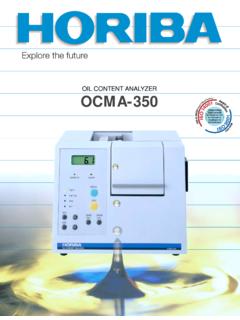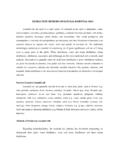Transcription of B HOP EXTRACTION - Supercritical Fluid Technologies
1 BEER HOP EXTRACTION RUDY BASKETTE, Supercritical Fluid Technologies , INC INTRODUCTION The practice of beer brewing is seven thousand years old and has out survived most of the cultures that drank it. While the ancient Babylonians, Romans, Assyrians, and Incan cultures can no longer partake in the nectar of the gods, striving to brew the best beer is still a prevalent goal. One of the methods to improve the flavor of a beer is to enhance the intensity of the hops. Supercritical carbon dioxide hop EXTRACTION is a method to obtain hop oil extracts with high concentrations (both yield and purity) and quality (less artifacts).
2 There are 3 major chemical components to hops: -acids, -acids, and essential oils. When hops are added to boiling wort, -acids such as humulone, thermally degrade to their iso- form. Isomerized - acids induce bitter flavoring for the beer, as well as providing a slight antibiotic effect against gram positive bacteria. Unlike -acids, -acids do not isomerize during the wort boiling process. -acids, such as lupulone, leisurely oxidize during the fermentation and storage phases of the brewing process. Isomerized -acid bitterness disintegrates during storage, since -acids emerge during the later stages of the brewing process; they provide a more biting bitter flavor.
3 Hops have certain flavor profiles ranging from citrusy, woodsy, spicy, or fruity. The essential oils aspect of the hops is where these different scents lie. Adding hops in to the early stages of boiling wort degrades all essential oils. So, dry hops are added to the end stages of boiling wort or after the wort is cooled to harness the scents in the beer. To extract maximal flavor profiles, SFT developed a lab-scale method using the SFT-110 SFE to extract hop oil. A two-step Supercritical carbon dioxide EXTRACTION allows the separation of the aromatic/essential oils from the bittering agents in hops.
4 The SFT-110 produces a natural, unaltered oil extract that amplifies natural hop flavor profiles. Using this method, brewers can acquire a truly enhanced flavor for their customers to enjoy. The SFT-110 utilizes pressurized carbon dioxide, allowing EXTRACTION to take place in room temperature environments, so a purer, less thermally decomposed extract is generated. Carbon dioxide is also advantageous, because it does not introduce any residual organic chemicals, meaning that all extracts are safe to consume. CO2 EXTRACTION extends the life of hop flavors. Hop pellets easily degrade, but the integrity of a hop oil extract can be maintained in a veritable climate.
5 Carbon dioxide EXTRACTION using the SFT-110 can separate the oils in a clean, energy efficient fashion. EQUIPMENT Analytical Balance SFT-110 SFE Unit SFT 100 cc Sample Vessel SFT 100 cc Sample Bag MATERIALS Hop pellets 2 SFT Collection Vials 1 SFT Vent Tube Figure 1. SFT-110 SFE Unit EXPERIMENTAL PROCEDURE A simple two-step SFE EXTRACTION method using the SFT-110 was employed to separate aromatic from bitter components of hops. Four samples: Sorachi Ace, Summit, Brewer s Gold, and Northern Brewer hop pellets were utilized for this experiment. All the samples were harvested in 2011 and bought from Label Peelers Inc.
6 Weigh 20 grams of hop pellets on an analytical balance. Grind up pellets to 1mm x 1mm and load into the SFT 100 cc Sample Bag. Place the SFT 100 cc Sample Bag into a SFT 100 cc sample vessel (10kpsi, 200 C operation). Seal the vessel and set into a SFT-110 SFE unit. Two fractions of oil will be collected via multiple (10) soak and dynamic flow steps. Place a chilled pre-weighed SFT collection vial on the flow line. Extract the samples according to the following parameters: EXTRACTION PARAMETERS Two fractions of oil will be collected via multiple soak and dynamic flow cycles according to the guidelines below.
7 FRACTION 1: ESSENTIAL OIL EXTRACT Pressure: 2180 psi Temperature: 40 C CO2 10 static and dynamic steps for 15 minutes apiece Flow Rate: 4mL/min After Fraction 1, change out the collection vial and replace with another clean, tared vial for fraction 2 products. FRACTION 2: BITTERING COMPOUNDS Pressure: 4350 psi Temperature: 40 C CO2 10 static and dynamic steps for 15 minutes apiece Flow Rate: 4mL/min After Fraction 2, you can remove the SFT 100 cc sample bag from the SFT-100 cc vessel and proceed to clean the SFT-110 SFE. RESULTS The aromatic extracts will yield a distinctly different color product than the bittering extract.
8 Fraction 1, the essential oil and aromatic hop EXTRACTION , will yield a bright yellow product. Fraction 2, the bittering compound EXTRACTION product, will yield a dark yellow, light brownish color. Hop Type Yield @ 2180 psi (g/100 g) Yield @ 4350 psi (g/100g) Total Yield Sorachi Ace Summit Brewer's Gold Northern Brewers Table 1. SFE-CO2 Hop Variety EXTRACTION Yields Table 1 is the EXTRACTION yield results for the 4 hop types at 2180 and 4350 psi. These particular hops were chosen specifically for their high oil content. As you can see Sorachi Ace, commonly used for its lemon and dill essence in IPA and Pale Ale, has the highest total yield of products.
9 Summit, Northern Brewer, and brewer Gold respectively followed in yield product. Figure 2. SFE-CO2 EXTRACTION of Sorachi Ace Figure 2 is the EXTRACTION yield results for Sorachi Ace at 2180 and 4350 psi. Basically this table is serving to indicate the yield of SFE CO2 hop EXTRACTION at specific time intervals. Figure 3. GC/MS Sorachi Ace extract @ 4350 psi Figure 3 is the GC/MS chromatograph of Sorachi Ace extract at 4350 psi. Notice the presence of lupulone and lupulone constituents, -acids. CONCLUSIONS Aromatic and bitter components of hops can be extracted using the lab-scale SFT-110 SFE Unit.
10 Supercritical CO2 Sorachi Ace yielded the highest aromatic and bitter fractions. GC/MS analysis of Sorachi Ace bitter oil fraction yielded lupulone and lupulone constituents. These compounds are solely characteristic of bitter fractions. Distinctive aromatic compounds, humulone or its isomers were present in the GC/MS analysis of Sorachi Ace at 2180 psi, indicating that the 2-phase EXTRACTION was indeed successful in separating aromatic and bitter components. EXTRACTION can isolate specific components with slight adjustments to temperature or pressure.








